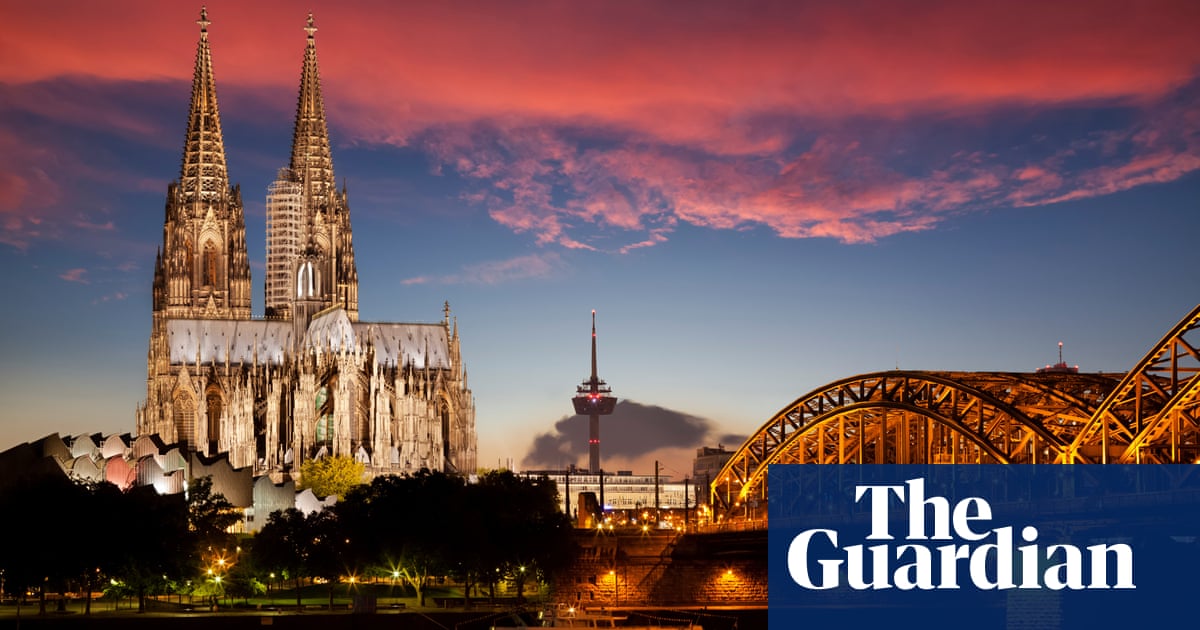It’s on about our fifth Kölsch that we begin to get the idea of Cologne’s constitution. We are sitting in Päffgen, one of the traditional brewhouses that produce the pale yellow beer unique to the German city. It comes in small straight glasses (it loses its fizz quickly apparently) and each time one is emptied, another one is delivered by a waiter swinging a kranz, or circular tray, which appears to defy gravity. The process of replacement goes on until you place a beer mat on top of your glass to signal that you’ve had enough.
I imagine my limit of four is only the beginning for many of the drinkers packing the room, but we soak up the alcohol with traditional dishes of pork schnitzel, meatloaf and – for the vegetarian – three fried eggs with fried potatoes, all of which are declared delicious, if not the healthiest food.
Cologne, Germany’s fourth-largest city, is less than four and a half hours from London by Eurostar and connecting Ice train, a fact that takes many by surprise. Berlin is a further four hours away, but in attitude is a million miles from Cologne with its ultra laid-back reputation. This attitude is reflected in its unofficial constitution, the Kolsche Grundgesetz, with aphorisms such as Et es wie et es (It is what it is) and, appropriately on this occasion, Drinkste ene met (Come on, have a drink).
We’re based at the Qvest hotel, in a neogothic building in the Belgian quarter which once housed the city’s archives. Slotted into a quiet square – opposite the charming fourth-century St Gereon church – its sweeping stone staircase and gothic shaped arches and windows are the perfect backdrop to its uber cool art and furniture, from Eames chairs to Pietro Derossi’s bright green Pratone take on the chaise longue. It also wins on the solo traveller front, with fun single rooms in the attic.
From here, most attractions are within a 30-minute walk. There is something to be said for smaller cities if you have only 48 hours in which to see everything.
We could even have visited its main sight and been back in London that night. It’s not often that you step out of a central station and immediately set eyes on one of the most important cathedrals in Europe. Arriving at Rome Termini, you would need to walk for about an hour to reach St Peter’s Basilica, while in Paris, Notre-Dame is a 40-minute stroll from Gare du Nord.
Unesco-listed Cologne Cathedral, the tallest twin-spired church in the world, looms over the station, a forever reminder of resilience in a city that was subjected to sustained allied bombing during the second world war, including the RAF’s first 1,000-bomber raid, in 1942. Though badly damaged, the cathedral – which took over 600 years to build and was completed in 1880 – survived amid a city of rubble, seeming to refuse to buckle under the onslaught.
A short distance from the cathedral is the Ludwig Museum, home to Europe’s biggest collection of pop art and an amazing Picasso collection (and a pretty good cafe/restaurant). A short walk away is Kolumba, the art museum of the archdiocese of Cologne created by Swiss architect Peter Zumthor over recently excavated Roman ruins and the medieval ruins of the Church of St Kolumba. The building is striking on the outside but inside it is breathtaking. Parting heavy, full-length leather curtains (a Zumthor signature), we navigate wooden walkways over the ruins, which surround Gottfried Bohm’s Madonna in the Rubble chapel, built in 1949 to replace the bombed out church.
The art collection has plenty of what you might expect – religious icons, a room of seals and seal boxes – but also some fantastic contemporary pieces, including one of Andy Warhol’s Crosses series and The Lair, a bronze cast by Louise Bourgeois.
after newsletter promotion
We have a professional secondhand shopper among us so head to Cologne’s vintage stores, which are mixed in with mainstream retailers along the city’s main shopping route, Ehrenstrasse. This results in a bargain purchase from Think Twice, but no joy from Vintage Revivals this time.
Most of day two is taken up by a trip to the Arp Museum in Rolandseck, 50 minutes away by train, in search of Dada masterpieces, something lacking in Cologne itself, despite the city being part of the early 20th-century movement. The abstract collages and paintings of Hans Arp and and Sophie Taeuber-Arp are uplifting on a dull day, even though we find architect Richard Meier’s building less engaging.
Despite thinking we could do it all, we are going home with unfinished business – we passed through cool, multicultural Ehrenfeld district at lightning speed and failed to find time for Kaffee und Kuchen. Still, as the constitution puts it: Es kommt, wie es kommt! (It goes like it goes!).

